Opinion & Analysis
Did Jason Day just have the best putting year of any Tour pro ever?
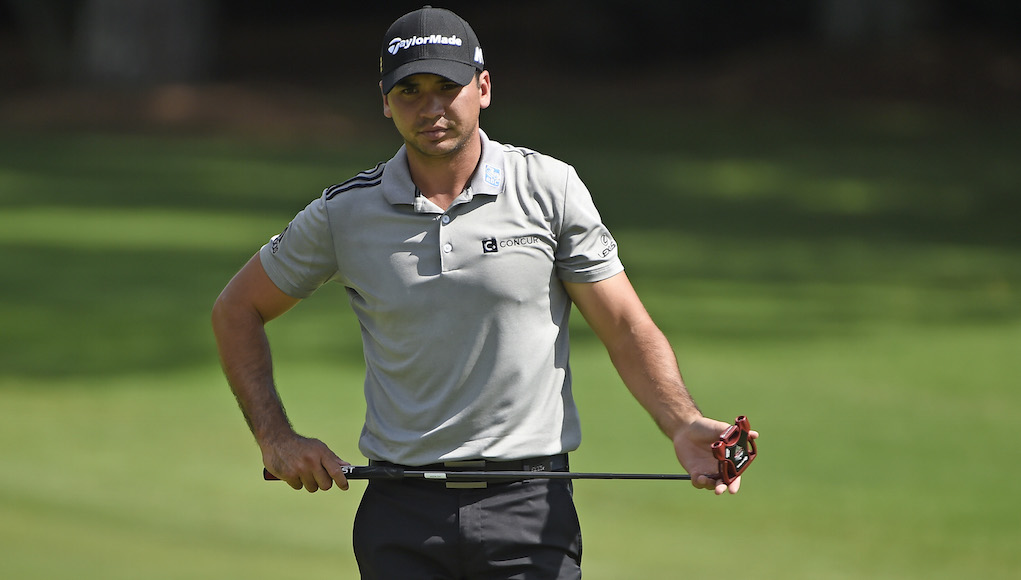
Jason Day was ranked No. 1 in Strokes-Gained Putting for the 2016 season. His average Strokes Gained on the field per round was an incredible 1.13 strokes (4.52 strokes per event). For context, this is the largest advantage recorded over the 13 years for which Strokes-Gained Putting is now available. This article explains how his performance was superior, and why I believe it is the best ALL TIME.
What is Strokes-Gained Putting?
The PGA Tour added its new Strokes-Gained Putting analysis in 2011. It was a revolutionary breakthrough in analysis, and a huge departure from the myopic, one-dimensional putting stats of yesteryear (number of putts per round and number of putts per GIR’s).
Simply stated, Strokes-Gained Putting places a numeric value on each putting opportunity based on distance from the hole. The result of the shot (or putt) is: [Start Value – Number of Putts to Hole Out]. The starting distance values on the PGA Tour are based upon the average performance on Tour since 2004 when ShotLink was implemented. My company, ShotByShot.com, uses start values that are based on the average performance of all of the “Scratch” rounds recorded in our system since 2003 (Scratch = 0 differential from Slope Adjusted Course Rating).
Start = 8 ft. Value = 1.50 (A Tour player will make this putt 50 percent of the time).
# Putts: 1; SG = 0.5 (1.5 – 1.0 = 0.5)
# Putts: 2; SG = 0-.5 (1.5 – 2.0 = -0.5)
Here’s an example of how Strokes-Gained Putting works. Let’s say a golfer has an 8-foot putt, which the stats say a player should make 50 percent of the time. The putt is given a value of 1.5. If the golfer makes it, he/she gains 0.5 strokes on the field. If the golfer misses it, he/she loses 0.5 strokes on the field.
There is a complete explanation of Strokes Gained and its history on my website: ShotByShot.com.
Back to J. Day
I have conducted a detailed study of the No. 1-ranked player each year since 2011. The results provide valuable perspective for the Tour players with whom I work. Because the Tour now produces this analysis as far back as ShotLink was collecting the data, I can now include players from 2004 forward.
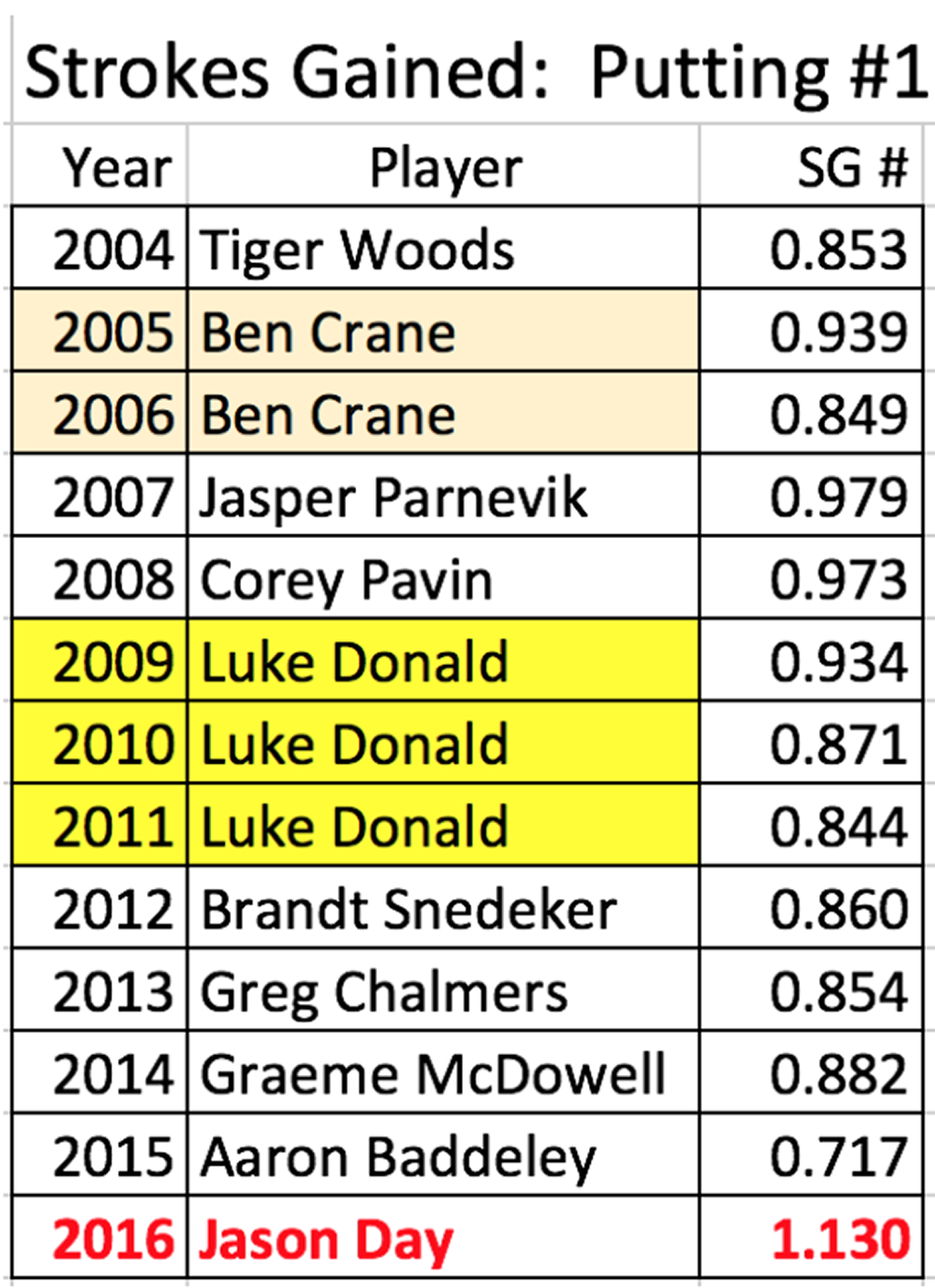
P.S. I found it worthy to note that Ben Crane was the best putter on Tour for two consecutive years and Luke Donald for THREE!
Jason Day vs. the No. 1s
I was immediately curious to see what Day did to overshadow all of the prior No. 1s. Could it be that he three-putted fewer times than the other 12? No! Day’s 2.4 percent rate of three-putts per holes played was actually the second highest among his No. 1 peers.
Side Note: For the benefit of the rest of us, the average 10-handicap’s three-putt avoidance is 8.5 percent, or almost three times that of the Tour’s 3.04 percent average.
And no, Day also did not one-putt with greater frequency than the other No. 1s. It was his unusual consistency that set him apart.
We all have our good and bad days on the greens AND, so do the best putters on Tour… except Day in 2016. In 16 events this year where Strokes Gained was measured, he never had a negative Strokes-Gained Putting result. None of the No. 1s had ever done that.
Have a look at the numbers in the graph below. Only Tiger came close in 2004 with only one negative Strokes-Gained event.
Jason Day vs. 2016 Tour Average
Finally, I looked into exactly what separated Day by 1.13 shots every round from the rest of the Tour in 2016. Only 18 percent of the difference resulted from fewer three-putts (see three-putt avoidance above). The remaining 82 percent resulted from increased one-putts, particularly Day’s very high standard in the range of 6-to-15 feet.
My research showed me long ago that on Tour the range of 6-10 feet separates the good putters from the pack, while the range of 11-20 feet determines the winners. Day’s putting no doubt played a major role in his three wins, ten Top-10s, $8+ million earned and his No. 1 ranking.
Is Jason’s 2016 putting season the best EVER?
We can easily agree that it is the best since 2004. The numbers are clear. And I don’t believe that there could have been a better putting season prior to 2004, because there have been too many important advancements in technology and agronomy in the past 14 years.
Technology: The quality and consistency of the balls and putters has dramatically improved, and so have the instruction tools. Further, with vastly improved analysis by distance ranges, players have much better information on exactly where they need to work to compete.
Agronomy: Putting surfaces are simply much better. Improved strains of grass and dramatically improved maintenance equipment and practices produce consistently smoother putting surfaces.
We will never know for sure, but I am confident that Day’s performance, at least as captured by ShotLink, is the best ever. It will be fun to see if it can be topped in the years to come.
- LIKE62
- LEGIT10
- WOW8
- LOL1
- IDHT0
- FLOP0
- OB0
- SHANK4
19th Hole
Vincenzi’s LIV Golf Singapore betting preview: Course specialist ready to thrive once again

After another strong showing in Australia, LIV Golf will head to Sentosa Golf Club in Singapore looking to build off of what was undoubtedly their best event to date.
Sentosa Golf Club sits on the southern tip of Singapore and is one of the most beautiful courses in the world. The course is more than just incredible scenically; it was also rated 55th in Golf Digest’s top-100 courses in 2022-2023 and has been consistently regarded as one of the best courses in Asia. Prior to being part of the LIV rotation, the course hosted the Singapore Open every year since 2005.
Sentosa Golf Club is a par 71 measuring 7,406 yards. The course will require precise ball striking and some length off the tee. It’s possible to go low due to the pristine conditions, but there are also plenty of hazards and difficult spots on the course that can bring double bogey into play in a hurry. The Bermudagrass greens are perfectly manicured, and the course has spent millions on the sub-air system to keep the greens rolling fast. I spoke to Asian Tour player, Travis Smyth, who described the greens as “the best [he’s] ever played.”
Davis Love III, who competed in a Singapore Open in 2019, also gushed over the condition of the golf course.
“I love the greens. They are fabulous,” the 21-time PGA Tour winner said.
Love III also spoke about other aspects of the golf course.
“The greens are great; the fairways are perfect. It is a wonderful course, and it’s tricky off the tee.”
“It’s a long golf course, and you get some long iron shots. It takes somebody hitting it great to hit every green even though they are big.”
As Love III said, the course can be difficult off the tee due to the length of the course and the trouble looming around every corner. It will take a terrific ball striking week to win at Sentosa Golf Club.
In his pre-tournament press conference last season, Phil Mickelson echoed many of the same sentiments.
“To play Sentosa effectively, you’re going to have a lot of shots from 160 to 210, a lot of full 6-, 7-, 8-iron shots, and you need to hit those really well and you need to drive the ball well.”
Golfers who excel from tee to green and can dial in their longer irons will have a massive advantage this week.
Stat Leaders at LIV Golf Adelaide:
Fairways Hit
1.) Louis Oosthuizen
2.) Anirban Lahiri
3.) Jon Rahm
4.) Brendan Steele
5.) Cameron Tringale
Greens in Regulation
1.) Brooks Koepka
2.) Brendan Steele
3.) Dean Burmester
4.) Cameron Tringale
5.) Anirban Lahiri
Birdies Made
1.) Brendan Steele
2.) Dean Burmester
3.) Thomas Pieters
4.) Patrick Reed
5.) Carlos Ortiz
LIV Golf Individual Standings:
1.) Joaquin Niemann
2.) Jon Rahm
3.) Dean Burmester
4.) Louis Oosthuizen
5.) Abraham Ancer
LIV Golf Team Standings:
1.) Crushers
2.) Legion XIII
3.) Torque
4.) Stinger GC
5.) Ripper GC
LIV Golf Singapore Picks
Sergio Garcia +3000 (DraftKings)
Sergio Garcia is no stranger to Sentosa Golf Club. The Spaniard won the Singapore Open in 2018 by five strokes and lost in a playoff at LIV Singapore last year to scorching hot Talor Gooch. Looking at the course setup, it’s no surprise that a player like Sergio has played incredible golf here. He’s long off the tee and is one of the better long iron players in the world when he’s in form. Garcia is also statistically a much better putter on Bermudagrass than he is on other putting surfaces. He’s putt extremely well on Sentosa’s incredibly pure green complexes.
This season, Garcia has two runner-up finishes, both of them being playoff losses. Both El Camaleon and Doral are courses he’s had success at in his career. The Spaniard is a player who plays well at his tracks, and Sentosa is one of them. I believe Sergio will get himself in the mix this week. Hopefully the third time is a charm in Singapore.
Paul Casey +3300 (FanDuel)
Paul Casey is in the midst of one of his best seasons in the five years or so. The results recently have been up and down, but he’s shown that when he’s on a golf course that suits his game, he’s amongst the contenders.
This season, Casey has finishes of T5 (LIV Las Vegas), T2 (LIV Hong Kong), and a 6th at the Singapore Classic on the DP World Tour. At his best, the Englishman is one of the best long iron players in the world, which makes him a strong fit for Sentosa. Despite being in poor form last season, he was able to fire a Sunday 63, which shows he can low here at the course.
It’s been three years since Casey has won a tournament (Omega Dubai Desert Classic in 2021), but he’s been one of the top players on LIV this season and I think he can get it done at some point this season.
Mito Pereira +5000 (Bet365)
Since Mito Pereira’s unfortunate demise at the 2022 PGA Championship, he’s been extremely inconsistent. However, over the past few months, the Chilean has played well on the International Series as well as his most recent LIV start. Mito finished 8th at LIV Adelaide, which was his best LIV finish this season.
Last year, Pereira finished 5th at LIV Singapore, shooting fantastic rounds of 67-66-66. It makes sense why Mito would like Sentosa, as preeminent ball strikers tend to rise to the challenge of the golf course. He’s a great long iron player who is long and straight off the tee.
Mito has some experience playing in Asia and is one of the most talented players on LIV who’s yet to get in the winner’s circle. I have questions about whether or not he can come through once in contention, but if he gets there, I’m happy to roll the dice.
Andy Ogletree +15000 (DraftKings)
Andy Ogletree is a player I expected to have a strong 2024 but struggled early in his first full season on LIV. After failing to crack the top-25 in any LIV event this year, the former U.S. Amateur champion finally figured things out, finished in a tie for 3rd at LIV Adelaide.
Ogletree should be incredible comfortable playing in Singapore. He won the International Series Qatar last year and finished T3 at the International Series Singapore. The 26-year-old was arguably the best player on the Asian Tour in 2023 and has been fantastic in the continent over the past 18 months.
If Ogletree has indeed found form, he looks to be an amazing value at triple-digit odds.
- LIKE3
- LEGIT3
- WOW1
- LOL2
- IDHT0
- FLOP2
- OB0
- SHANK0
Opinion & Analysis
Ryan: Lessons from the worst golf instructor in America

In Tampa, there is a golf course that boasts carts that do not work, a water range, and a group of players none of which have any chance to break 80. The course is overseen by a staff of crusty men who have succeeded at nothing in life but ending up at the worst-run course in America. However, this place is no failure. With several other local courses going out of business — and boasting outstanding greens — the place is booked full.
While I came for the great greens, I stayed to watch our resident instructor; a poor-tempered, method teacher who caters to the hopeless. At first, it was simply hilarious. However, after months of listening and watching, something clicked. I realized I had a front-row seat to the worst golf instructor in America.
Here are some of my key takeaways.
Method Teacher
It is widely accepted that there are three types of golf instructors: system teachers, non-system teachers, and method teachers. Method teachers prescribe the same antidote for each student based on a preamble which teachers can learn in a couple day certification.
Method teaching allows anyone to be certified. This process caters to the lowest caliber instructor, creating the illusion of competency. This empowers these underqualified instructors with the moniker of “certified” to prey on the innocent and uninformed.
The Cult of Stack and Jilt
The Stack and Tilt website proudly boasts, “A golfer swings his hands inward in the backswing as opposed to straight back to 1) create power, similar to a field goal kicker moving his leg in an arc and 2) to promote a swing that is in-to-out, which produces a draw (and eliminates a slice).”
Now, let me tell you something, there is this law of the universe which says “energy can either be created or destroyed,” so either these guys are defying physics or they have no idea what they are taking about. Further, the idea that the first move of the backswing determines impact is conjecture with a splash of utter fantasy.
These are the pontifications of a method — a set of prescriptions applied to everyone with the hope of some success through the placebo effect. It is one thing for a naive student to believe, for a golf instructor to drink and then dispel this Kool-Aid is malpractice.
Fooled by Randomness
In flipping a coin, or even a March Madness bet, there is a 50-50 chance of success. In golf, especially for new players, results are asymmetric. Simply put: Anything can happen. The problem is that when bad instructors work with high handicappers, each and every shot gets its own diagnosis and prescription. Soon the student is overwhelmed.
Now here’s the sinister thing: The overwhelming information is by design. In this case, the coach is not trying to make you better, they are trying to make you reliant on them for information. A quasi Stockholm syndrome of codependency.
Practice
One of the most important scientists of the 20th century was Ivan Pavlov. As you might recall, he found that animals, including humans, could be conditioned into biological responses. In golf, the idea of practice has made millions of hackers salivate that they are one lesson or practice session from “the secret.”
Sunk Cost
The idea for the worst golf instructor is to create control and dependency so that clients ignore the sunk cost of not getting better. Instead, they are held hostage by the idea that they are one lesson or tip away from unlocking their potential.
Cliches
Cliches have the effect of terminating thoughts. However, they are the weapon of choice for this instructor. Add some hyperbole and students actually get no information. As a result, these players couldn’t play golf. When they did, they had no real scheme. With no idea what they are doing, they would descend into a spiral of no idea what to do, bad results, lower confidence, and running back to the lesson tee from more cliches.
The fact is that poor instruction is about conditioning players to become reliant members of your cult. To take away autonomy. To use practice as a form of control. To sell more golf lessons not by making people better but through the guise that without the teacher, the student can never reach their full potential. All under the umbrella of being “certified” (in a 2-day course!) and a melee of cliches.
This of course is not just happening at my muni but is a systemic problem around the country and around the world, the consequences of which are giving people a great reason to stop playing golf. But hey, at least it’s selling a lot of golf balls…
- LIKE17
- LEGIT1
- WOW0
- LOL4
- IDHT1
- FLOP0
- OB0
- SHANK17
19th Hole
Vincenzi’s 2024 Zurich Classic of New Orleans betting preview

The PGA TOUR heads to New Orleans to play the 2023 Zurich Classic of New Orleans. In a welcome change from the usual stroke play, the Zurich Classic is a team event. On Thursday and Saturday, the teams play best ball, and on Friday and Sunday the teams play alternate shot.
TPC Louisiana is a par 72 that measures 7,425 yards. The course features some short par 4s and plenty of water and bunkers, which makes for a lot of exciting risk/reward scenarios for competitors. Pete Dye designed the course in 2004 specifically for the Zurich Classic, although the event didn’t make its debut until 2007 because of Hurricane Katrina.
Coming off of the Masters and a signature event in consecutive weeks, the field this week is a step down, and understandably so. Many of the world’s top players will be using this time to rest after a busy stretch.
However, there are some interesting teams this season with some stars making surprise appearances in the team event. Some notable teams include Patrick Cantlay and Xander Schauffele, Rory McIlroy and Shane Lowry, Collin Morikawa and Kurt Kitayama, Will Zalatoris and Sahith Theegala as well as a few Canadian teams, Nick Taylor and Adam Hadwin and Taylor Pendrith and Corey Conners.
Past Winners at TPC Louisiana
- 2023: Riley/Hardy (-30)
- 2022: Cantlay/Schauffele (-29)
- 2021: Leishman/Smith (-20)
- 2019: Palmer/Rahm (-26)
- 2018: Horschel/Piercy (-22)
- 2017: Blixt/Smith (-27)
2024 Zurich Classic of New Orleans Picks
Tom Hoge/Maverick McNealy +2500 (DraftKings)
Tom Hoge is coming off of a solid T18 finish at the RBC Heritage and finished T13 at last year’s Zurich Classic alongside Harris English.
This season, Hoge is having one of his best years on Tour in terms of Strokes Gained: Approach. In his last 24 rounds, the only player to top him on the category is Scottie Scheffler. Hoge has been solid on Pete Dye designs, ranking 28th in the field over his past 36 rounds.
McNealy is also having a solid season. He’s finished T6 at the Waste Management Phoenix Open and T9 at the PLAYERS Championship. He recently started working with world renowned swing coach, Butch Harmon, and its seemingly paid dividends in 2024.
Keith Mitchell/Joel Dahmen +4000 (DraftKings)
Keith Mitchell is having a fantastic season, finishing in the top-20 of five of his past seven starts on Tour. Most recently, Mitchell finished T14 at the Valero Texas Open and gained a whopping 6.0 strokes off the tee. He finished 6th at last year’s Zurich Classic.
Joel Dahmen is having a resurgent year and has been dialed in with his irons. He also has a T11 finish at the PLAYERS Championship at TPC Sawgrass which is another Pete Dye track. With Mitchell’s length and Dahmen’s ability to put it close with his short irons, the Mitchell/Dahmen combination will be dangerous this week.
Taylor Moore/Matt NeSmith +6500 (DraftKings)
Taylor Moore has quickly developed into one of the more consistent players on Tour. He’s finished in the top-20 in three of his past four starts, including a very impressive showing at The Masters, finishing T20. He’s also finished T4 at this event in consecutive seasons alongside Matt NeSmith.
NeSmith isn’t having a great 2024, but has seemed to elevate his game in this format. He finished T26 at Pete Dye’s TPC Sawgrass, which gives the 30-year-old something to build off of. NeSmith is also a great putter on Bermudagrass, which could help elevate Moore’s ball striking prowess.
- LIKE8
- LEGIT3
- WOW1
- LOL1
- IDHT0
- FLOP3
- OB1
- SHANK2
-

 19th Hole1 week ago
19th Hole1 week agoJustin Thomas on the equipment choice of Scottie Scheffler that he thinks is ‘weird’
-

 19th Hole1 week ago
19th Hole1 week ago‘Absolutely crazy’ – Major champ lays into Patrick Cantlay over his decision on final hole of RBC Heritage
-

 19th Hole3 weeks ago
19th Hole3 weeks agoTwo star names reportedly blanked Jon Rahm all week at the Masters
-

 19th Hole2 weeks ago
19th Hole2 weeks agoReport: LIV Golf identifies latest star name they hope to sign to breakaway tour
-

 19th Hole2 weeks ago
19th Hole2 weeks agoNeal Shipley presser ends in awkward fashion after reporter claims Tiger handed him note on 8th fairway
-

 19th Hole2 weeks ago
19th Hole2 weeks agoBrandel Chamblee has ‘no doubt’ who started the McIlroy/LIV rumor and why
-

 Equipment3 weeks ago
Equipment3 weeks agoWhat we know about Bryson DeChambeau’s 3D-printed Avoda irons
-

 19th Hole6 days ago
19th Hole6 days agoLET pro gives detailed financial breakdown of first week on tour…and the net result may shock you

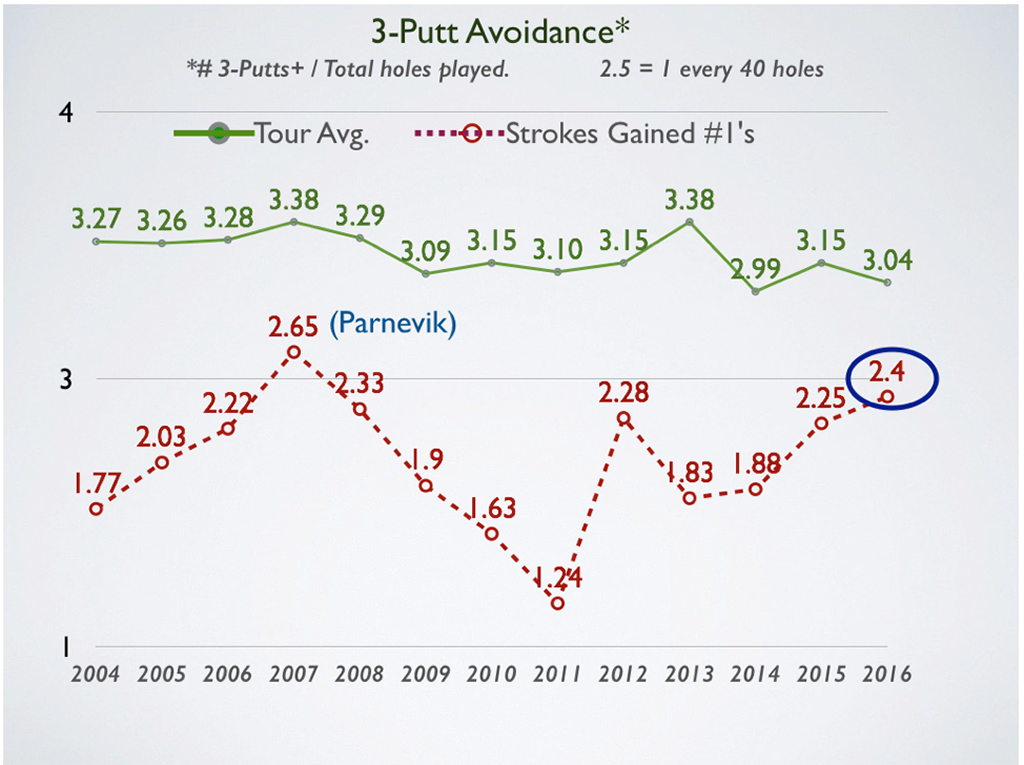
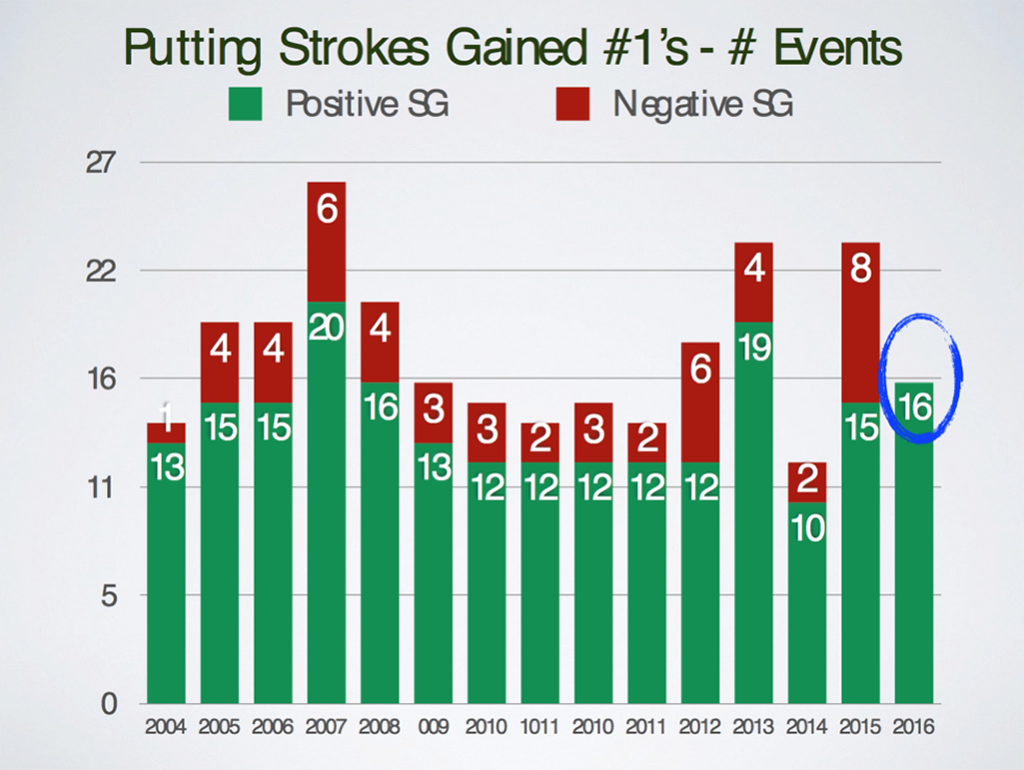
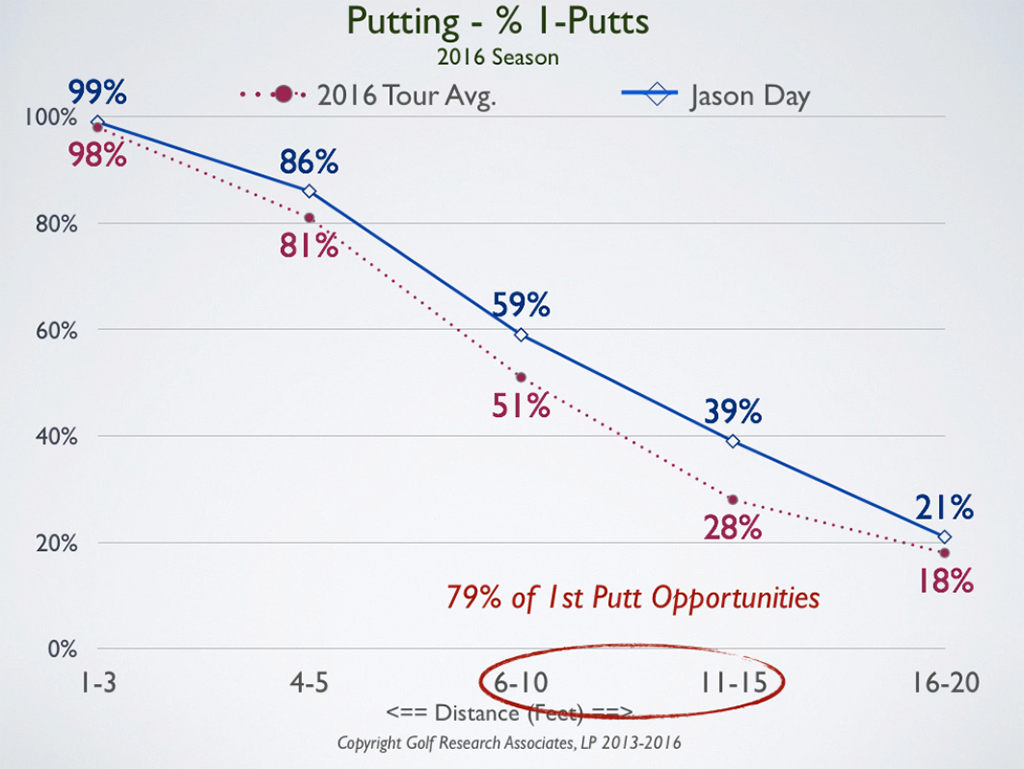


















Tony Wright
Dec 13, 2016 at 1:59 pm
Peter congratulations on an absolutely terrific article!
adam
Nov 14, 2016 at 7:10 pm
I think the stat could be further enhanced by adding the difficulty of a putt, in addition to the distance. The pro average on a straight, 8-foot uphill putt is going to be substantially better than 50%. Wouldn’t be surprised to see downhill, 8-foot sliders come in at 20%.
The good player will, of course, leave himself with easier putts. So, perhaps Day has the wedge control to dial in an 8-foot, uphill putt on a consistent basis. Does this make him a better putter, or just a better wedge player. Hmmm.
Tal
Nov 15, 2016 at 12:47 am
That’s the next stage of SG putting. Taking break angle and severity into account! That would be awesome! Although even the best wedge players in the world can’t leave themselves a straight uphill putt all the time. So Day’s good putting is unlikely to be as a result of always leaving himself straight putts. If he could do that, he may as well just drop the ball off in the hole every time. TV distorts our view of why pro golfers are better than even top amateurs. It’s little improvements in all areas that make the difference. They can’t choose exactly where to leave the ball on the green.
For perspective, his total SG tee to green (including .375 strokes per round around the greens) was .987 strokes per round. He gained 1.310 strokes per round putting. Despite gaining strokes around the greens, this shows his putting was more valuable to him than his short game, proving his putting stats are down to his putting like the author said.
adam
Nov 15, 2016 at 12:06 pm
He’s a good putter, no doubt. However, every player with a wedge in his hand is trying to create a favorable putting situation (while minimizing risk). When you can move the ball and control trajectory and distance, you’re going to leave yourself with easier putts. Isn’t that the basis of Striker’s game? Of Furyk’s?
However, I think the stat isn’t all that helpful at present. You’d need much more sophisticated data gathering and analysis. This has to be the next step for the stat to be truly meaningful.
Tal
Nov 16, 2016 at 6:00 am
I think it’s a very complete stat. There is room for improvement for sure, but it’s better than any other putting stat we have. Like you said, every player is looking for the best putt and again, these guys aren’t as accurate as tv makes them look froom 100 in. For this reason, SG is still able to measure pure putting skill better than any other stat we have. (It does take uphill and downhill into account too, by the way)
Peter
Nov 16, 2016 at 3:30 pm
Adam,
I actually started with SG Putting 28 years ago and worked with quite a number of LPGA players (easier to get to know). My observations and limited testing did NOT reveal meaningful differences in relative difficulty. When MIT got into the SG game in 2010, they agreed that an 8 ft. putt is valued at 1.5 regardless of up down or sideways.
Finally, on that point, imagine the added complexity of data entry – a major barrier to usage.
mark
Nov 14, 2016 at 10:00 am
All I have to say is Jordan Speith’s putting in 2015 was the best Ive ever seen along with Tiger when he was on top. I don’t care what stats say.
Uhit
Nov 14, 2016 at 11:04 am
They shot some outstanding putts, several times shown in the highlights of the tour…
…but the (unspectacular) average was not shown, nor remembered.
If I would collect all my spectacular shots in a best of…
…you would assume, that I have to be the best player ever…
…just like most of us, if we only look at our highlights. 😉
…but if we look at our stats (if we would collect them…), you see, that we are far away from the top.
ian
Nov 14, 2016 at 1:23 pm
Yup
Tal
Nov 14, 2016 at 5:39 pm
Spieth is an awesome putter for sure! His approach play and highly efficient driving were the keys to his great 2015 season though. His putting didn’t account for all of his winning advantage.
Uhit
Nov 13, 2016 at 1:08 pm
“Strokes-Gained Putting places a numeric value on each putting opportunity based on distance from the hole”
Is a chip from 30 ft to a hole also a putting opportunity, if the player could use a putter?
Is a put from outside the green from 30 ft to a hole also a putting opportunity?
Or has a putting opportunity to be on the green?
A close chip and a additional put from 30 ft distance, is the same as two putts from 30 ft distance?
…and independent whether both strokes happened on the green, or not?
…and a three put from 60 ft on the green vs. a 40 ft chip plus a 18 ft put plus a additional 2 ft put?
Maybe Jason Day just knew better than most, how to play the last approach shot (to get in a better position) for the following put?
I think there still are many variables left, and SG is just another try to quantify something, that is barely quantifyable in a correct manner.
Tal
Nov 13, 2016 at 6:45 pm
Only putts on the green count. Everything else around the green is accounted for by the strokes gained short game stat. It can be broken down further though.
Uhit
Nov 13, 2016 at 8:01 pm
Ok, but then, it makes not that much sense, to look at the putting SG isolated…
…because the outcome is also depending from the short game.
If Day successfully tried to achieve uphill putts with his short game, he had an advantage for his putts – if the rest of the field did not take that opportunity in the same way.
It is hard to tell, but anyway, Day was really good, and maybe even the best around the hole – more often than others during the season.
Tal
Nov 13, 2016 at 8:17 pm
SG accurately (enough) demonstrates skill in individual areas compared to the field average. It also somewhat nullifies variables such as rough length and course condition by building a database of millions of shots over time.
You’re right though; having the best SG putting stats doesn’t mean you scored the best. If you’re constantly hitting the ball to 3 feet then you’d be the best iron player in the world, but we’d learn little about your ability to putt. The SG stat system only works as a whole. I think the reason people over-analyse SG putting is because they’re still clinging to the idea that putting is the most important part of the game. SG data shows this to not necessarily be the case.
Uhit
Nov 14, 2016 at 4:28 am
Yes, you are probably right, that maybe the strive to see the putting as the holy grail of golf is a part of the over-interest in putting stats…
…and I can understand this, because if you have a 10´ birdie put on a par five, it is hard to accept, that you can make more than one put to finish the hole…
…3 strokes for 550 yards and 3 strokes for 10´ is hard to accept…
…especially with the same club in hands.
A 70 year old golfer can be a better putter than a 17 year old.
Putting is for everyone – long driving is not.
Putting is the hope for the not that gifted player…
…no matter what stats you are using.
Tal
Nov 14, 2016 at 5:20 pm
I totally agree. It’s hard to accept hitting an approach to 5 feet and missing the putt. People confuse the missed birdie opportunity because of a missed putt with the fact that putting is more important to scoring, simply because it’s the last thing you remember.
Peter
Nov 16, 2016 at 3:35 pm
Uhit,
On Tour, only putts on the putting surface count as putts. In ShotByShot.com, I recommend that players count those shots from just off the green or on the fringe to be putts. If counted as Chips, their chipping results will be artificially improved. At the same time, shots that are truly chipping opportunities ARE chips even if the putter is the club of choice.
Uhit
Nov 17, 2016 at 3:30 am
Thank you Peter for the clarification.
It is always a compromise, where to draw the line between (partly) interchangeable things.
I remember a player, that chipped on a green, over a spike mark, into the hole (Garcia?).
The SG stats are similar to a score card…
…one don´t see the quality of the single shots, but you get a good idea, how well someone played –
which is exactly the case in this article, where the SG stats help to identify a outstanding putting performance of a single player.
Hans
Nov 13, 2016 at 4:07 am
First, thanks for doing the research into how consistency was the real difference (that’s what makes this article interesting). That said, it does at the same time beg the question of what makes for the “best” putter. If some guys stats are lower because he putted worse when he was out of contention, does that make him a worse putter or simply less focused when he mattered less and money when it did matter. And we might care about the latter more, than the former. Still, a nice result by day to stay above average every single event, it says sthg good about his method.
Another thing tho, it makes me wonder how much the distribution of the types of putts a player has affects the SG stat. For instance in a day one player might have more 5-10 footers than other players. Etc for other distances. And there might be certain distances where players have a better chance of getting positive SG over the field. As an example, I could imagine if you give some guys a combo say 25-30 foot putts all day that they lag close, plus tap ins fro, from chips, that their strokes gained might not have a lot of room to be very high unless his name is spieth. But you give the same dude a bunch of 10 footers and his ability to turn a good putting day into extra strokes on the field becomes much stronger, simply because you can affect the make percentage more. Not saying that those are the distances where that would happen, but more that there might be some critical distances where you can push your SG ahead the most (or lose the most) and so what distances you putt from could affect your ability to move the SG needle.
Tal
Nov 13, 2016 at 8:33 pm
On your point about distribution of putts, that’s exactly what SG is for. It’s superior to simply counting putts as it takes both distance to the hole and how well you performed from that distance relative to the field. Let’s say you hit every shot from 150 in to 1 foot. Your SG putting would show nothing special but you’d be the greatest iron player in history and assuming your driving wasn’t horrible, you would win every tournament you played in.
Day’s superior putting performance is down to just that; superiorly consistent putting because the SG stats show that ignoring all other factors (i.e taking SG putting in isolation) he outperformed the field by over 1 stroke per round. That’s a MASSIVE advantage. His driving and approach play added further strokes to his advantage.
Peter
Nov 16, 2016 at 3:36 pm
Well Said Tal. Thanks!
Tal
Nov 13, 2016 at 8:49 pm
SG isn’t the same as just counting putts. If you hole an 8 footer, you gain more strokes to the field than holing a 2 footer. So, if Day was only ever putting from very close to the hole due to great chipping, his SG putting wouldn’t show anything special, but his SG short game would. This article has only taken putting in isolation though, so maybe putting and short game were strong for Day last season. SG though, measures pure putting skill in a way that no other stat can. If you’re interested, you should read ‘Every Shot Counts’ by Mark Broady. It answers all these questions.
K dawg
Nov 12, 2016 at 7:49 pm
Sorry but Speith’s putting the year before is the best ever. If the stats don’t identify that…then they aren’t measuring correctly.
Tal
Nov 13, 2016 at 8:35 pm
You’re basing this off of television highlights.
Pingback: Did Jason Day just have the best putting year of any Tour pro ever? – Swing Update